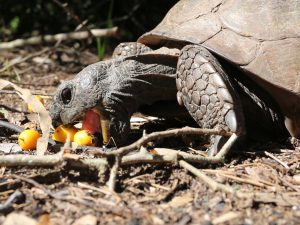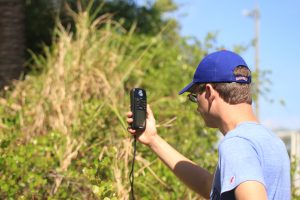
If you’ve ever thought about traveling to an exotic foreign location to be part of a critically important research project, George Heinrich has just the trip for you.
A field biologist and environmental educator, Heinrich is looking for citizen-scientists to assist with documenting populations of the threatened gopher tortoise. The good news — it’s happening in Pinellas County. And, it’s free.
“People travel all over the world to do this kind of work, but they’re needed here too,” he says. “This is an opportunity for individuals to learn about an imperiled species while participating in actual wildlife research that will benefit local populations.”
Around the world, turtles are among the most endangered species of all. They rank with frogs and primates in their potential for extinction, Heinrich said. And with habitat loss a leading cause for the decline, it’s vitally important that current populations are mapped so that management plans can be developed to protect them.

He’s recruiting volunteers now to survey gopher tortoise burrows at two locations this spring. They’ll survey Hammock Park in Dunedin in February and then Boyd Hill Nature Preserve in St. Petersburg in March and April.
Hammock Park Survey First for Heinrich
“This is our first time at Hammock Park but we know it’s home to a small population of gopher tortoises,” he said. “We’ll walk transects through the uplands where we would expect to find tortoises and search for their burrows.”
Mapping tortoises at Hammock Park is particularly important because it was recently expanded to include eight acres of uplands that are known to be tortoise habitat, Heinrich said. “Friends of the Hammock approached us about doing the survey so they can develop management plans to protect them.”
Boyd Hill Populations Largest in Southern Pinellas County

On the other hand, tortoise burrow surveys have been completed at Boyd Hill Nature Preserve every other year for the past eight years, with the most recent survey showing 135.5 tortoises in residence — the largest population in southern Pinellas County.
About 150 acres of uplands provide potential habitat, but like most Florida habitats, they must be managed to function properly, he said. Without prescribed burns, shrubby vegetation will shade out open habitat that the tortoises prefer.
Data Guides Management Plans
The data collected by Heinrich and his volunteers guides the city’s management plans to maintain and expand gopher tortoise populations, said Barbara Stalbird, the city’s natural and cultural areas manager.
“We know some areas need ongoing management but we also survey areas adjacent to those high-density sectors to see if improvements there could expand populations. It’s a slow process but we can improve certain areas and then see gopher tortoises moving into them.”
Volunteer citizen-scientists are critical to that effort, she adds. “Without committed volunteers, we wouldn’t have the budget to do these surveys as often as we do now. The data inform the decisions we make to perform management activities that support the gopher tortoises.”
For More Information:
Visit the Florida Fish and Wildlife Conservation page on gopher tortoises,
Contact Heinrich to learn more about this project or to sign up as a volunteer, email george@heinrichecologicalservices.com.
Learn more about George Heinrich and his long career sharing his love for turtles at http://baysoundings.com/teaching-the-three-ts-turtles-tortoises-and-terrapin/.
